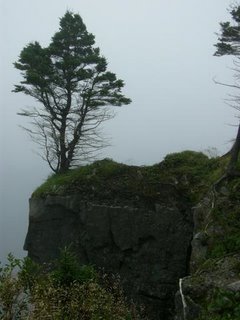This was my Gold Qualifying journey for the Duke of Edinburgh’s Award Program, and it was one of the first trips that made me think about the changing ways people have lived in Newfoundland and Labrador. Colinet Island was once home to a few hundred people who made their living mostly from the cod fishery. But the residents made the decision to resettle in 1960.
Resettlement refers to the programs, funded by the provincial and federal governments, which provided various levels of support and encouragement to residents of small communities to leave for larger centres. The rationale was simple. People wanted services – schools, medical care, roads – and Newfoundland’s isolated, scattered population made providing those services prohibitively expensive. So, from 1954 to 1975, the government supported (or coerced, depending on your perspective) the removal of about 30,000 people from isolated coastal communities to larger towns, completely vacating about 300 communities.
Resettlement is almost a dirty word in Newfoundland, linked with ideas of government abandonment of rural communities and the forced removal of thousands of people from their homes. The true picture of resettlement, of course, is much more complicated. Many of the residents felt forced to leave, betrayed by government and their neighbours. Many were happy to move their families to where they had better opportunities for education and employment.
Whatever the feelings of the residents of resettled communities, 4 days on Colinet Island showed me that Reginaville and Mosquito (the two abandoned communities) were once somebody’s home. There are house foundations and chimneys, and the remains of fish plants on the beaches were the residents would once have gone to work. The Reginaville church is identifiable by its front steps, and the church in Mosquito had collapsed, leaving a pile of wooden siding, tarpaper, stained glass and bird nests.

The graveyards are perhaps the most interesting places on the island. It’s possible to reconstruct entire families, but I always ask more questions. How did Francis Power die at the age of 17? What was John Linehan doing in Brooklyn, New York when he died?
In his fine play about resettlement “West Moon,” Al Pittman suggested that forgetting the dead was worse than death itself. I’m not sure that’s true – it’s human nature to move on. But there is something sad in about these abandoned places, and something comforting in knowing that they are visited by people from time to time.
Most of these resettled communities are difficult to reach, but there are some that are relatively easily accessible. La Manche on the Southern Shore is only a 30 minute drive and 20 minute walk from St. John’s. Kerley’s Harbour and British Harbour, on the Bonavista Peninsula near the Random Passage film set, are also fairly accessible.
You can see more pictures of Colinet Island here, courtesy of the Maritime History Archive.
P.S. I wish I had more pictures of Colinet Island. This trip was before the days of digital cameras, and looking through my old photo albums really made me realize how much easier to is to record your trips when you can preview your shots and you’re not limited by film exposures.

My mother Mary Power was born (1925)and lived 16 years on what I thought was Mosquito island (obviously Mosquito on Colinet Island). She traveled to Ontario where I live today. Visited the ruins 1964 at age 12 with mom and dad
ReplyDeletewho was the Felix that was used to get over to colinet island. I would like to go over there on my visit this JUne. Email me at shawnpower76@hotmail.com
ReplyDeleteThat would have been Felix Dobbin. he passed away in 2008
Delete